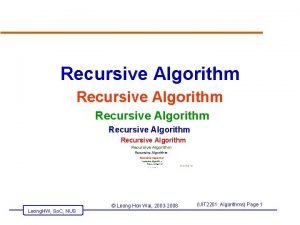Excursion Tracker Excursion Algorithm 1 of 4 Get







- Slides: 7

Excursion Tracker

Excursion Algorithm (1 of 4) Get input velocity at station in order from downstream to upstream Generate a time series of normalized velocity values for each station where each semidiurnal low and high are 0 and 1, respectively Generate a time series of Signal To Noise Ratio (SNR) for each station Generate a time series of the lowest SNR for each tidal cycle (snr. Lo) Define an object Lo. To. Lo. Cycle that stores the start and end of each tidal cycle Create a list of Lo. To. Lo. Cycle for each station

Excursion Algorithm (2 of 4) Loop through the time span of data Find each tidal cycle low at the most downstream station For each upstream station If the Snr. Lo is good Find the nearest low velocity (normalized value of 0) Else Use the same low time as the downstream station Find the peak of each cycle

Lo. To. Lo. Cycle

Excursion Algorithm (3 of 4) Loop through the Lo. To. Lo. Cycle list for each station (in any order) Identify ebbs from zero-to-zero velocity (or from low-to-low, if no zero) Calculate and store excursion track and total Identify floods from zero-to-zero velocity (or from peak-to-peak, if no zero) Calculate and store excursion track and total Link each ebb to the prev/next ebb and prev/next flood Calculate the combined total excursion for each pairing of flood and following ebb (prev. Pair. Sum)

Excursion Algorithm (4 of 4) Loop through all ebbs at all stations If prev. Pair. Sum is greater than that of either the previous or next ebb Select this ebb and the flood that follows it as the largest daily excursion

Whisker Plots











